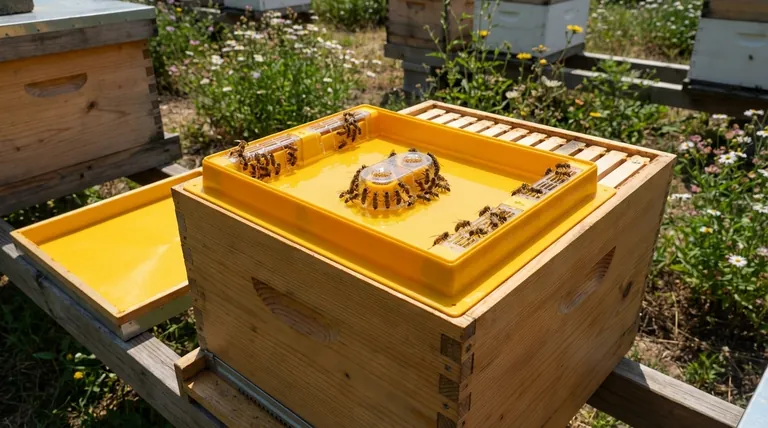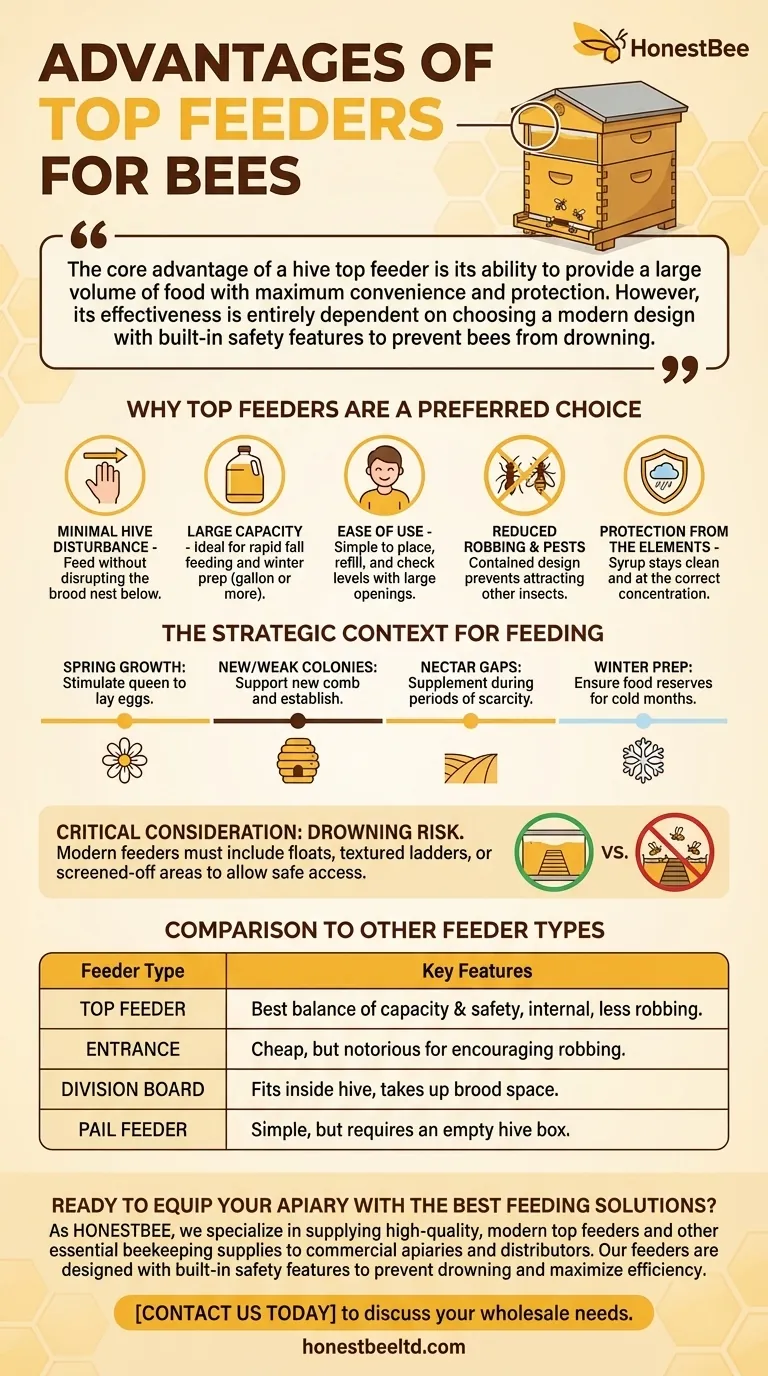When considering how to feed your bees, top feeders present a compelling solution due to their high capacity, safety, and minimal disruption to the colony. These feeders sit directly on top of the hive bodies, allowing you to deliver large quantities of syrup efficiently while protecting it from pests and preventing robbing from other hives.
The core advantage of a hive top feeder is its ability to provide a large volume of food with maximum convenience and protection. However, its effectiveness is entirely dependent on choosing a modern design with built-in safety features to prevent bees from drowning.

Why Top Feeders are a Preferred Choice
A top feeder’s design directly addresses several common challenges beekeepers face when providing supplemental nutrition to their colonies.
Minimal Hive Disturbance
Because the feeder is located at the very top of the hive stack, you can inspect food levels and refill it simply by removing the outer and inner covers. This means you can feed the colony without disturbing the brood nest below.
Large Capacity
Top feeders are designed to hold a significant amount of syrup, often a gallon or more. This makes them exceptionally useful for fall feeding, when the goal is to quickly help a colony stock up on winter stores.
Ease of Use
These feeders are among the most straightforward to operate. They are simple to place on the hive, and their large openings make refilling a quick and clean process with minimal spillage.
Reduced Robbing and Pests
Unlike external entrance feeders, a top feeder is contained entirely within the hive. This design drastically reduces the chances that the syrup's scent will attract ants, wasps, or bees from neighboring colonies, which can trigger robbing behavior.
Protection from the Elements
The feeder's position inside the hive protects the syrup from being diluted by rain or degraded by direct sunlight. This ensures the feed remains clean and at the correct concentration for the bees.
The Strategic Context for Feeding
Using a top feeder is a tactical decision based on the colony's specific needs throughout the year. Feeding is not always necessary but is a critical management tool in certain situations.
Stimulating Spring Growth
Providing syrup in early spring can stimulate the queen to lay eggs, helping the colony build its population rapidly ahead of the main nectar flow.
Supporting New or Weak Colonies
A newly hived swarm or a small nucleus colony needs significant resources to draw out new comb and establish itself. A top feeder provides the steady supply of carbohydrates they need to grow quickly.
Bridging Nectar Gaps
Sometimes there is a period of scarcity between major floral blooms, often called a "dearth" or "gap." Supplemental feeding during these times ensures the colony doesn't consume all its existing stores.
Preparing for Winter
The most common use for a large-capacity top feeder is to ensure the colony has enough food reserves to survive the long, cold winter months when they cannot forage.
Understanding the Trade-offs and Risks
While highly effective, top feeders are not without potential downsides. Acknowledging these trade-offs is key to using them successfully.
The Critical Drowning Risk
The most significant disadvantage is the risk of bees drowning in the syrup. Older or poorly designed models have open reservoirs that can be death traps. Modern feeders must include floats, textured ladders, or screened-off areas that allow bees to access the syrup safely without falling in.
Slower Syrup Access (In Some Designs)
Certain top feeder designs only allow a limited number of bees to access the syrup at one time through a mesh screen. While this can prevent a feeding frenzy, it may be slower than other methods like pail or division board feeders.
Comparison to Other Feeder Types
Top feeders are one of four main styles. Entrance feeders are cheap but notorious for encouraging robbing. Division board feeders fit inside the hive like a frame but take up brood space. Pail feeders are simple but require an empty hive box to enclose them. Each has its place, but the top feeder often provides the best balance of capacity and safety.
Making the Right Choice for Your Goal
Selecting the right feeding strategy depends entirely on your objective for the colony.
- If your primary focus is rapid fall feeding for winter prep: A large-capacity top feeder with proper safety features is the ideal choice for its volume and efficiency.
- If your primary focus is stimulating a small nucleus colony: A top feeder is effective, but you must ensure its design prevents even a small number of bees from drowning.
- If your primary focus is supplemental feeding during a strong nectar flow: Remember that a top feeder occupies the top position, which may delay your ability to add another honey super.
By matching your feeder choice to the specific needs of your bees, you can provide effective support that keeps your colony healthy and productive throughout the year.
Summary Table:
| Advantage | Key Benefit |
|---|---|
| Minimal Hive Disturbance | Feed without disrupting the brood nest. |
| Large Capacity | Ideal for rapid fall feeding and winter prep. |
| Reduced Robbing & Pests | Contained design prevents attracting other insects. |
| Ease of Use | Simple to place, refill, and check levels. |
| Protection from Elements | Syrup stays clean and at the correct concentration. |
Ready to equip your apiary with the best feeding solutions?
As HONESTBEE, we specialize in supplying high-quality, modern top feeders and other essential beekeeping supplies to commercial apiaries and distributors. Our feeders are designed with built-in safety features to prevent drowning and maximize efficiency.
Contact us today to discuss your wholesale needs and discover how our equipment can support the health and productivity of your colonies.
Visual Guide

Related Products
- Professional Hive Top Bee Feeder for Beekeeping
- HONESTBEE Professional Hive Top Bee Feeder Feeding Solution
- HONESTBEE Round Hive Top Bee Feeder for Syrup
- HONESTBEE Entrance Bee Feeder Professional Hive Nutrition Solution for Beekeeping
- Boardman Entrance Bee Feeder Durable Galvanized Steel and Wood Construction for Beekeeping
People Also Ask
- What are the features of top feeders for bees? Maximize Hive Health with Safe, High-Capacity Feeding
- What are the advantages of hive top feeders? Maximize Feeding Efficiency for Your Apiary
- What types of hive boxes is the round hive top feeder compatible with? Universal Fit for 8 & 10-Frame Langstroth Hives
- What is the best bee feeder for a hive? Choose the Right Feeder for Your Apiary's Scale
- How to use a top feeder in a beehive? A Guide to Effective Beehive Feeding



















